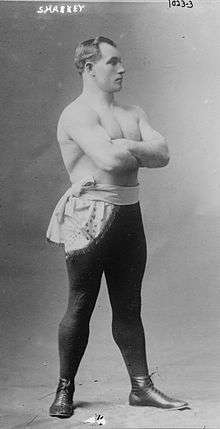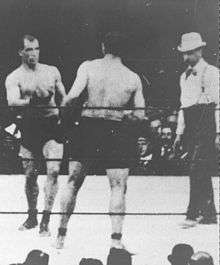Tom Sharkey
| Tom Sharkey | |
|---|---|
 | |
| Statistics | |
| Nickname(s) | Sailor |
| Rated at | Heavyweight |
| Height | 5 ft 8 in (1.73 m) |
| Reach | 70 in (178 cm) |
| Nationality | Irish |
| Born |
November 26, 1873 Dundalk, Ireland |
| Died | April 17, 1953 (aged 79) |
| Stance | Orthodox |
| Boxing record | |
| Total fights | 52 |
| Wins | 40 |
| Wins by KO | 37 |
| Losses | 7 |
| Draws | 5 |
| No contests | 0 |
Thomas 'Sailor Tom' Sharkey (November 26, 1873 – April 17, 1953) was a boxer who fought two fights with heavyweight champion James J. Jeffries. Sharkey's recorded ring career spanned from 1893 to 1904. He is credited with having won 40 fights (with 37 KOs), 7 losses, and 5 draws. Sharkey was named to the Ring Magazine's list of 100 greatest punchers of all time.[1]
Background
Sharkey was born in Dundalk, Ireland. His story began when he ran away from home and went to sea as a cabin boy. In 1892, Sharkey landed in New York City and joined the United States Navy. He was eventually deployed to Hawaii where he began his pro fighting career.
Career
Standing 5 ft 8 in (1.73 m) or 5 ft 9 in (1.75 m) tall, Sharkey was a standup brawler, who came right after his opponents. Sharkey was easy to hit, but rough and tumble and a hard puncher. He had unusually broad shoulders for a man of his height, and sported a tattoo of a star and battleship on his chest. In 1900 he also acquired a large cauliflower ear, courtesy of a brawl with Gus Ruhlin, that added to his persona.
Sharkey's first bout against a front-line fighter occurred in 1896 when he fought Joe Choynski, who was later to knock out legendary heavyweight Jack Johnson, in an eight-round match. Sharkey followed that fight up by challenging "Gentleman Jim" Corbett. The two met and the fight was ruled a draw after four rounds due to police interference.
Sharkey vs. Fitzsimmons

On December 2, 1896, the San Francisco Athletic Club sponsored a fight at the Mechanics' Pavilion in San Francisco between Bob Fitzsimmons and Sharkey. Unable to find a referee, at the last minute they called on former lawman Wyatt Earp. He had officiated 30 or so matches in earlier days, though not under the Marquis of Queensbury rules.[2] The fight may have been the most anticipated fight on American soil that year. It had been billed for the heavyweight championship of the world, as it was thought that the champion, James J. Corbett had relinquished the crown.
Fitzsimmons was favored to win, and bets flowed heavily his way. Earp entered the ring still armed with his customary Colt .45 and drew a lot of attention when he had to be disarmed. He later said he forgot he was wearing it. Fitzsimmons was taller and quicker than Sharkey and dominated the fight from the opening bell. In the eighth round, Fitzsimmons hit Sharkey with his famed "solar plexus punch," an uppercut under the heart that could render a man temporarily helpless. The punch caught Sharkey, Earp, and most of the crowd by surprise, and Sharkey dropped, clutched his groin, and rolled on the canvas, screamed foul.[3]
Earp stopped the bout, ruling that Fitzsimmons had hit Sharkey when he was down. His ruling was greeted with loud boos and catcalls.[4] Earp based his decision on the Marquis of Queensbury rules, which state in part, "A man on one knee is considered down and if struck is entitled to the stakes." Very few witnessed the foul Earp ruled on. He awarded the decision to Sharkey, who attendants carried out as "...limp as a rag.".[5]
Sharkey vs. Jeffries

Sharkey claimed the heavyweight title until Corbett resumed his fighting career, who was recognized as the champion until he was knocked out by Fitzsimmons in a title bout. Sharkey was involved in another controversial fight when he faced Corbett on November 22, 1898. In this bout Sharkey manhandled the shifty and elusive Corbett. He threw him to the ground, hit him with hard punches to the body and head and seemed on the verge of imminent victory when one of Corbett's seconds jumped into the ring in the ninth round. The referee promptly disqualified Corbett and awarded the bout to Sharkey.
On January 10, 1899, Sharkey faced another ring legend, the tricky Kid McCoy. Sharkey knocked out McCoy in the tenth round thereby securing a shot at the heavyweight title then held by James J. Jeffries. The two had met previously, fighting a hotly contested 20-round slugfest on May 6, 1898. The decision went to Jeffries in a close fight. Nevertheless, Sharkey vowed to beat the 6'2½ burly Jeffries in the rematch.
The two fought a memorable twenty-five round bout on November 3, 1899 in Coney Island, New York. The match was the first championship fight filmed for motion pictures, and the lights required for the filming were so hot that they burned the hair from the top of both fighters' heads. The last round of the fight was not recorded, however, because the camera operator ran out of film.
The fight was a ring classic. Sharkey took the early lead when he battered the larger Jeffries during the early stages of the bout. Jeffries, however, was very powerful and gained control of the fight in the later rounds. Both fighters, despite suffering severe injuries during the bout went all out in the final round, which most believed was won by Jeffries. In any event the bout was awarded to Jeffries, although many felt Sharkey had won. During this fight the indomitable Sharkey suffered a broken nose and two broken ribs, and his left ear swelled to the size of a grapefruit. After this fight Jeffries and Sharkey became friends. Jeffries always claimed that Sharkey gave him his hardest fights stating that Sharkey was the roughest, toughest and bravest man he ever fought.
Death
Sharkey died in 1953 at the age of 79 and is buried at Golden Gate National Cemetery in San Bruno, California.
See also
| Titles in pretence | ||
|---|---|---|
| Preceded by Bob Fitzsimmons |
World Heavyweight Champion December 2, 1896 |
Vacant Title next held by Sam Langford |
References
| Wikimedia Commons has media related to Tom Sharkey. |
- ↑ "- TIME". www.time.com. April 27, 1953. Retrieved 2008-05-21.
- ↑ Reilly, Joe. "Born To Uphold The Law: Frank Sulloway's Principles Applied to the Earp-Clanton Feud of 1879–1882" (PDF). Drexel E-Repository and Archive. Retrieved June 6, 2011.
- ↑ Barra, Alan (November 26, 1995). "BACKTALK;When Referee Wyatt Earp Laid Down the Law". New York Times. Retrieved April 23, 2013.
- ↑ Rasmussen, Cecilia (June 4, 2000). "LA Then and Now: Mrs. Wyatt Earp Packed Her Own Punch". Los Angeles Times. Retrieved June 29, 2011.
- ↑ Shillingberg, William B. (Summer 1976). "Wyatt Earp and the Buntline Special Myth". Kansas Historical Quarterly. 42 (2): 113–154.